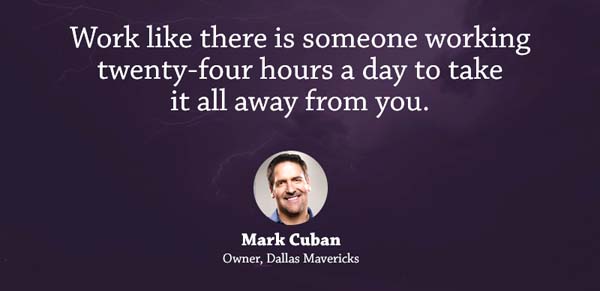Success Advice
6 Things You’ll Never Hear An Ambitious Person Say
Ambition is the path to success. Persistence is the vehicle you arrive in. – Bill Bradley
Ambition is one of those traits many of us don’t have enough of, If at all. You can’t blame the majority of people for not having any either, though it’s not an excuse. Through out our childhood we’re encouraged to get an education, get a job, and “just” get by. We’re encouraged to “just” have enough, do enough, and achieve an average amount. But there’s no ambition in achieving an “average” amount.
Ambition is about thinking enormous. Ambition is about thinking massive, and having an insane amount of drive to push you towards those goals. Any ambition we have as kids gets sucked out of us by the education system, not to mention our parents and those around us who lack ambition.
There are 6 words you’ll never hear an ambitious person say. And If you’re lacking some, you need to adopt these habits and ways of thinking!
1. It’s Impossible
Not only does it seem impossible until it’s done, there are countless people who have already done it. Ambitious people know this, and nothing is impossible to them as far as they see it.
And even if an ambitious person doesn’t know somebody’s already done it, they’ll still believe it’s possible anyway.
Look at the internet for example. Do you really believe the internet would exist If the creators thought it was “impossible“? Of course not.
And do you think countless creations would exist if the creators lacked ambition? No way. Nothing is impossible in the eyes of the ambitious!
“It always seems impossible until its done.” – Nelson Mandela
2. I can’t do that
An ambitious person has a “can do” attitude at all times. It’s a part of their DNA and a natural habit. Ambitious people believe “I can” no matter how insane, crazy, out of this world, unconventional, or challenging it might be.
A non ambitious person believes “I can’t” so as a result they don’t.
The meaning of ambition is a strong desire to do or achieve something. But you can’t have a strong desire to achieve something If you’re operating on a “can’t” mentality.
Whether you think you can or you think you can’t, you’re right. ― Henry Ford
3. I don’t have what it takes
You’ll never in your life time hear an ambitious person say “I don’t have what it takes“. Such a statement ain’t even a part of their mentality or vocabulary. Their brain doesn’t register or believe it.
Where as a non ambitious person believes they don’t have what it takes to achieve, succeed, or get something done. So they never have the guts, ability and drive to get it done. Period.
4. I’m not willing to do whatever it takes
Ambitious people are driven to succeed, achieve and accomplish what must be accomplished. Ambitious people will do whatever it takes to come out on top. and make it happen no matter what. Ambitious people are willing to pay the cost to get there, even If it means facing failure and dozens of setbacks.
Ambitious people are willing to keep pushing and keep moving forward, regardless of how many times they’re knocked down.
I’ll use Mark Cuban as an example. He failed many businesses and had to start over multiple times before he became successful. Ambitious people will do whatever it takes for however long it takes to succeed.
People who lack ambition aren’t willing to do that, so they settle for less.

5. Success is an option
Ambitious people don’t see success as an “option”, they see it as a MUST. They see success as a “succeed or die trying” mentality. They don’t see it as just an alternative, an option, or something there’s a “chance” they can have.
Ambitious people see it as a responsibility, a MUST, a commitment and a vow.
Non ambitious people don’t see it this way, so they get too comfortable and too relaxed with what they have.
6. I’ll never be successful
What you affirm is what you believe, and what you believe is what you’re destined to have. Ambitious people might have ups and downs like everybody does, but their core beliefs don’t change.
They’ll still believe they can be successful no matter how big the challenges are. And they’ll still believe they have what it takes to be successful no matter how difficult.
Find someone you know who has no ambition whatsoever, and I can guarantee you they don’t believe they’ll ever be successful. Ambitious people are too determined and focus to be thinking like that!
Hope you enjoyed this article. If you’ve got ambition, keep that ambition burning because you need it.
Feature Image originally by Brooks Brothers
Did You Know
How Skilled Migrants Are Building Successful Careers After Moving Countries
Behind every successful skilled migrant career is a mix of resilience, strategy, and navigating systems built for locals.

Moving to a new country for work is exciting, but it can also be unnerving. Skilled migrants leave behind familiar systems, networks, and support to pursue better job opportunities and a better future for their families. (more…)
Life
10 Research-Backed Steps to Create Real Change This New Year
This New Year could finally be the one where you break old patterns and create real, lasting change.

Every New Year, we make plans and set goals, but often repeat old patterns. (more…)
Change Your Mindset
The Silent Skill That Makes People Respect You Instantly
What truly earns respect and why most people go about it the wrong way

Everybody craves respect but not everyone earns it. Some people believe that a title, years of experience, or a position of authority automatically entitles them to respect. (more…)
Entrepreneurs
The Essential Skills Every Entrepreneur Needs In 2026
Success in the digital age isn’t about luck. It’s about mastering the skills that separate dreamers from doers.

When I was 22 years old, I started my first side hustle as a ghostwriter. (more…)
-

 Shift Your Mindset4 weeks ago
Shift Your Mindset4 weeks ago11 E’s That Define Every Great Leader And Why Most People Miss Them
-

 Did You Know4 weeks ago
Did You Know4 weeks agoThe Success Patterns You Inherited (And Didn’t Notice)
-

 Entrepreneurs3 weeks ago
Entrepreneurs3 weeks agoThe Essential Skills Every Entrepreneur Needs In 2026
-

 Business4 weeks ago
Business4 weeks agoThe Hidden Money Pit in Your Operations (and How to Use It)
-

 Change Your Mindset3 weeks ago
Change Your Mindset3 weeks agoHow to Turn Your Mind Into Your Greatest Asset (Instead of Your Enemy)
-

 Change Your Mindset2 weeks ago
Change Your Mindset2 weeks agoThe Silent Skill That Makes People Respect You Instantly
-

 Life2 weeks ago
Life2 weeks ago10 Research-Backed Steps to Create Real Change This New Year
-

 Tech2 weeks ago
Tech2 weeks agoWhat’s in a Name? How to Get Your Domain Right

























16 Comments